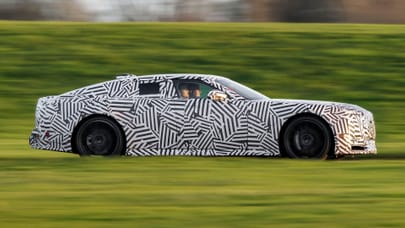
Opinion: can racing games actually make better cars?
BAC's simulator is a virtual version of the company's Mono sports car. In what way is this 'digital twin' useful?
Until recently, I’d been feeling pretty happy with my home sim racing setup. I’ve got a direct drive steering wheel and load cell pedal set from Fanatec, I’ve got a selection of increasingly elaborate wheel rims, bristling with buttons, and the whole lot is bolted to a sturdy Next Level Racing rig. Life was good.
I say I ‘had’ been feeling happy because a recent journey up to BAC’s headquarters near Liverpool to drive a Mono on the manufacturer’s simulator has spoilt all that. A bit like how that first surprise upgrade to business class on a flight makes every journey afterwards, folded up like a deckchair in economy, feel like a form of torture that should be banned under the Geneva Convention. BAC’s sim setup has ruined me for life.
Technically 'simulator' doesn’t really do it justice, this is what BAC is referring to as a ‘digital twin’. It’s a virtual version of the firm’s brilliant lightweight Mono sports car that is so close to the real thing that telemetry data between the two is interchangeable. You clamber into a tubeframe chassis, mounted on a six-degrees-of-freedom motion platform and surrounded by a wraparound projector screen, and try not to spin so dramatically that your lunch makes a surprise reappearance.
For a low volume manufacturer, a digital twin is useful in three major ways. The first is to familiarise new customers with the car in an environment that isn’t going to result in big bills, whether in the ‘repair’ or ‘hospital’ category. Intimidating as it looks, the Mono is actually reasonably approachable, but with a power to weight ratio of 525bhp per tonne, there’s a lot to be exploited.
The second is that these virtual versions of the firm’s cars could be plugged into the racing sims we play at home and sold as downloadable content. The current version of BAC’s simulator is based on tech from popular game rFactor 2, but the work done here could be applied in other consumer sims too. It feels like a strange thing to say, but by doing this, BAC is blurring the lines between automotive manufacturer and videogame developer.
The final and most exciting way it’s useful is as a development tool for the real world cars. Like F1 teams with their simulators, what BAC is chasing is what’s referred to as ‘correlation’ – the moment where the simulator and the real world numbers reliably line up. Once you’re there, you can start testing new concepts and even individual parts on the sim before you ever put them into production.
That’s how I came to be the first person outside of the company to drive a virtual version of the unannounced, hydrogen fuel cell powered BAC e-Mono. If you thought the regular Mono was sci-fi, this looks like it’s been plucked straight out of the next Tron movie and accelerates like Han Solo just pulled the hyperspace lever. Best I get another two hours’ practice on the simulator, then. Maybe three...
Top Gear
Newsletter
Thank you for subscribing to our newsletter. Look out for your regular round-up of news, reviews and offers in your inbox.
Get all the latest news, reviews and exclusives, direct to your inbox.
Trending this week
- Car Review
Renault Clio








